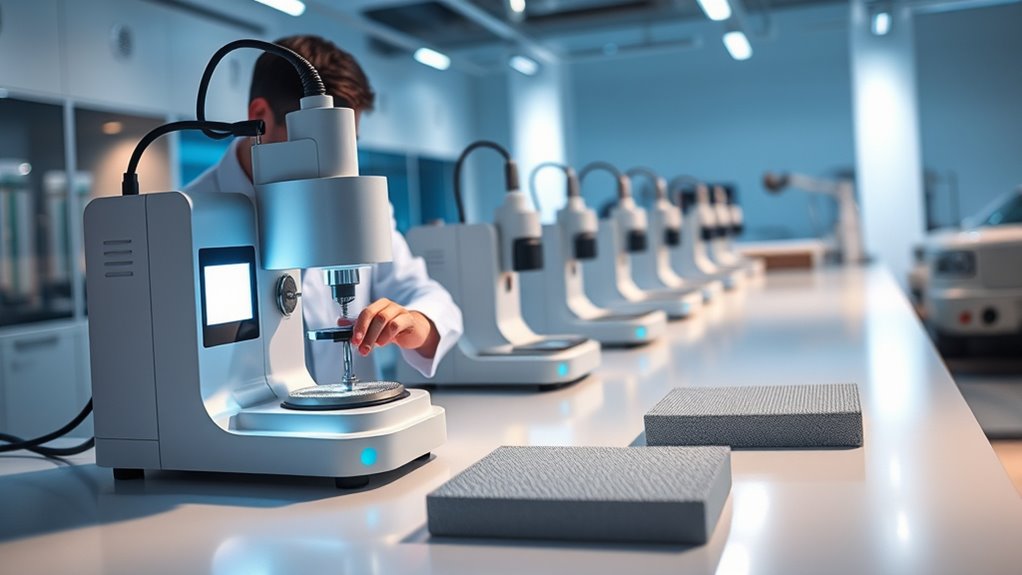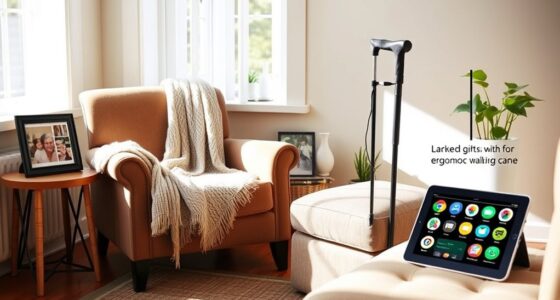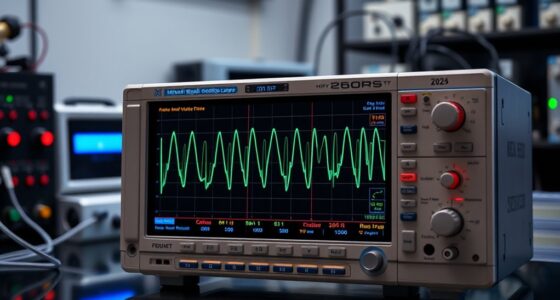If you’re seeking the 15 best surface profilometers for precise measurements in 2025, I recommend models like GOYOJO’s portable roughness testers, SUNNYSONG handheld analyzers, and high-accuracy profilometers with multi-parameter capabilities. These devices feature advanced sensors, quick results, and robust data management, making them ideal for quality control and research. Keep exploring to uncover detailed specs and how these tools can meet your specific needs.
Key Takeaways
- High-precision surface profilometers like GOYOJO and SUNNYSONG offer multi-parameter measurements (Ra, Rz, Rq, Rt) for comprehensive surface analysis.
- Portable, user-friendly designs with data storage, Bluetooth, and USB connectivity enable accurate field measurements and efficient data management.
- Industry-standard compliant models support quality control, aerospace, and medical applications requiring reliable, repeatable surface profiling.
- Advanced features such as diamond-tipped sensors and high-resolution LCD displays ensure precise, detailed surface characterization.
- Top models in 2025 balance measurement accuracy, ease of use, and connectivity, making them essential tools for surface quality assessments.
GOYOJO Surface Roughness Tester Profilometer
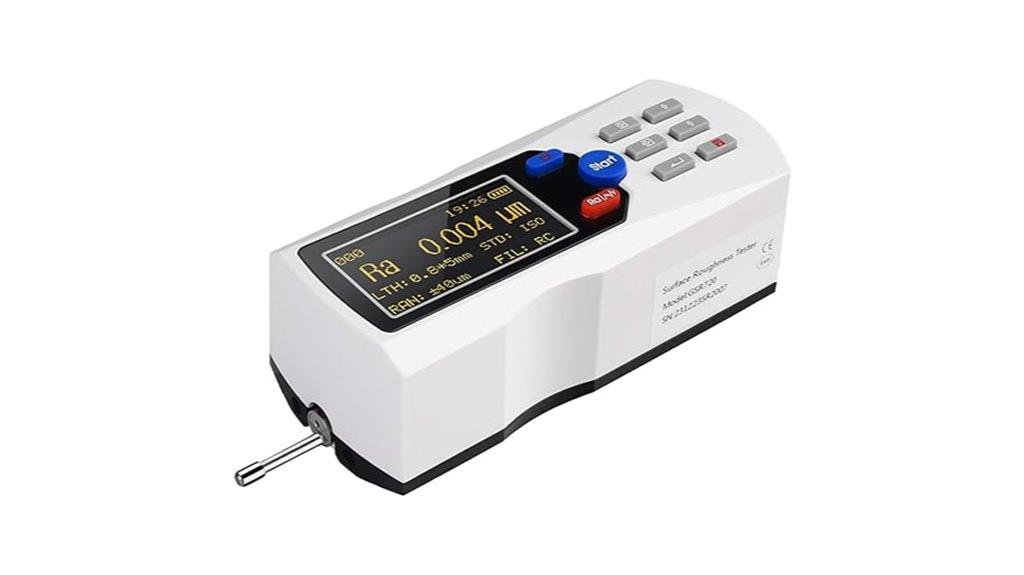
The GOYOJO Surface Roughness Tester Profilometer is an excellent choice for professionals who need high-precision digital surface measurements across various industries. It’s versatile enough for manufacturing, engineering, automotive, scientific research, and electronics. The device measures parameters like Ra, Rz, Rq, and more, providing extensive surface analysis. Its inductance sensor achieves outstanding accuracy, with a measurement range of 0.025-12.5μm and a resolution of 0.001μm. Compact and lightweight, it’s portable for on-site testing. The LCD display makes readings straightforward, and data storage supports up to 200 datasets. While some limitations exist, it remains a reliable, cost-effective tool for precise surface profiling.
Best For: professionals in manufacturing, engineering, automotive, scientific research, and electronics industries seeking high-precision surface roughness measurements.
Pros:
- High accuracy with a measurement range of 0.025-12.5μm and resolution of 0.001μm
- Portable and lightweight design for easy on-site testing
- Supports storage of up to 200 datasets with clear LCD display for straightforward data interpretation
Cons:
- Inability to export raw surface profile curves directly via USB or SD card
- SAVE button functionality issues reported by users
- Customer support response times and assistance may be limited
Surface Roughness Tester Handheld Surface Profilometer
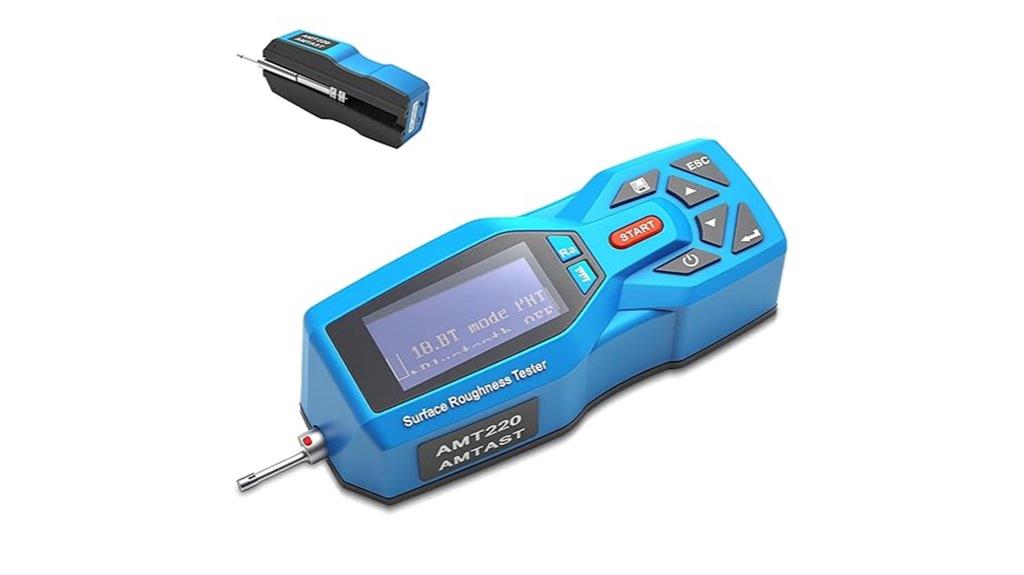
If you need a reliable, portable device for quick surface roughness measurements, a handheld surface profilometer is an ideal choice. Its compact, lightweight design (just 0.9 pounds) and Transformers-inspired style make it easy to handle and durable. It measures parameters like Ra, Rz, and Rsk, with high accuracy and compatibility with ISO, DIN, ANSI, and JIS standards. The device stores up to 100 measurement groups, features a bright OLED display, and connects wirelessly via Bluetooth (Android only). With over 20 hours of battery life, it’s perfect for shop environments, providing fast, precise readings in around 30 seconds with minimal setup.
Best For: professionals in manufacturing, automotive, or quality control seeking a portable, reliable surface roughness measurement tool for quick, accurate assessments.
Pros:
- Compact, lightweight design (0.9 pounds) for easy handling and portability
- Compatible with multiple international standards (ISO, DIN, ANSI, JIS) for versatile use
- Long battery life of over 20 hours ensures continuous operation in shop environments
Cons:
- Bluetooth connectivity available only for Android devices, limiting compatibility with other platforms
- Data download in text format requires extra steps for analysis in Excel or other software
- Minor software spelling issues and limited profile data download options may affect user experience
SUNNYSONG Handheld Digital Surface Roughness Tester Meter
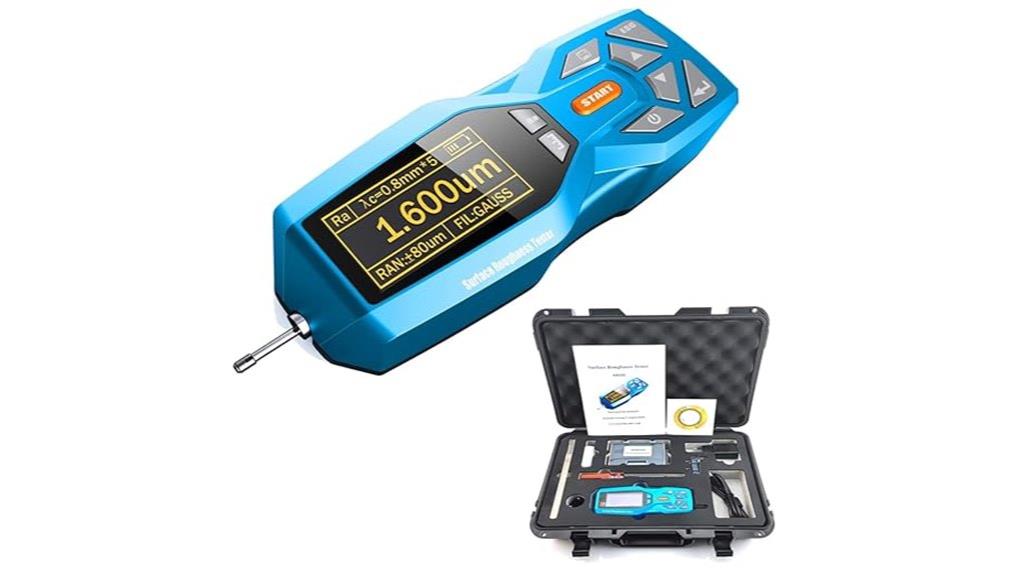
For professionals needing quick, accurate surface measurements in the field, the SUNNYSONG Handheld Digital Surface Roughness Tester Meter stands out. This portable profilometer measures 22 roughness parameters, including Ra, Rz, and Rpk, making it versatile for various industrial applications. Its high-precision inductance sensors ensure stable, reliable readings, even on curved surfaces or within small holes. The device features a clear LCD display for real-time results, graphical data output, and options to print or connect to a PC for seamless data management. Compact and user-friendly, it’s ideal for inspections, production line monitoring, and quality control in diverse environments.
Best For: professionals and technicians requiring quick, accurate surface roughness measurements in industrial, production, and quality control environments.
Pros:
- Provides accurate measurement of 22 surface roughness parameters, including Ra, Rz, and Rpk.
- Equipped with high-precision inductance sensors for stable and reliable readings on various surface types.
- Features a user-friendly LCD display, graphical data output, and options for printing or connecting to a PC for efficient data management.
Cons:
- May require training to fully utilize all 22 parameters and advanced features.
- The device’s portability means battery life could limit extended field use without recharge.
- As a specialized instrument, it might be more expensive than basic roughness testers, impacting budget-conscious users.
Surface Roughness Tester with LED Display and Calibration Block
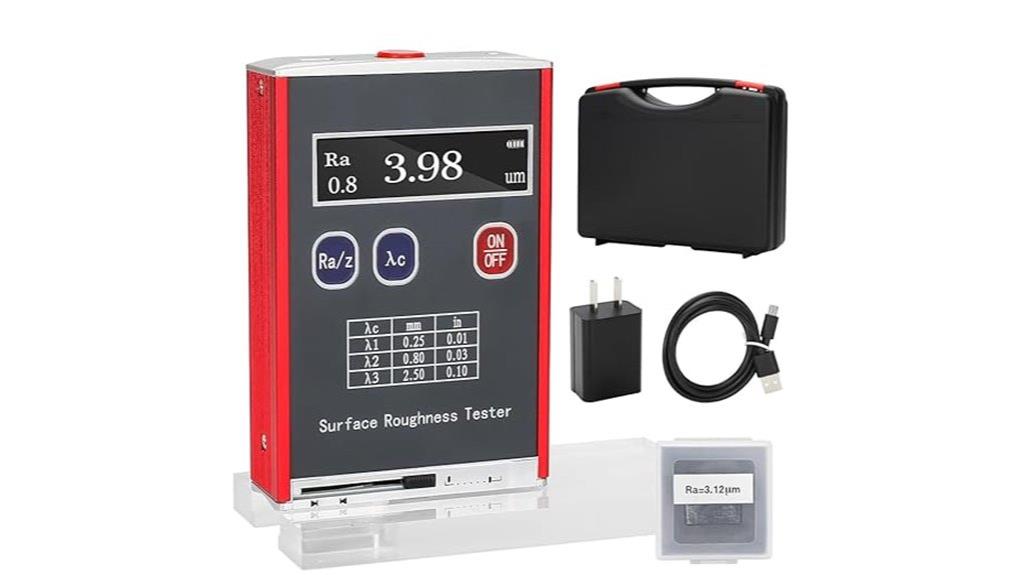
Surface Roughness Tester with LED display and calibration block stands out as an ideal choice for professionals demanding high-precision measurements in demanding inspection environments. With an accuracy of up to 0.01μm, it supports key parameters like Ra, Rq, Rz, and Rt, making it versatile across industries. Its high-speed DSP processor guarantees rapid data processing, while the portable, lightweight design features a clear dot-matrix LCD for real-time results. The professional kit, including a calibration block and accessories, assures consistent accuracy. Powered by a high-capacity lithium-ion battery and equipped with USB connectivity, this tester offers reliability and convenience for precise surface analysis in various sectors.
Best For: professionals in manufacturing, automotive, aerospace, electronics, and quality inspection sectors needing ultra-precise surface roughness measurements.
Pros:
- Ultra-high accuracy up to 0.01μm ensures reliable measurement results.
- Supports multiple key parameters (Ra, Rq, Rz, Rt) for versatile testing.
- Portable and lightweight design with real-time LCD display for convenience and ease of use.
Cons:
- May require familiarity with roughness parameters for optimal use.
- Limited to surfaces within the specified measurement range (Ra/Rq: 0.05~15.0μm, Rz/Rt: 0.1~50.0μm).
- As a professional-grade device, it could be relatively higher in cost compared to basic roughness testers.
Digital Surface Roughness Tester Surface Profilometer Gauge with Measuring Range Ra, Rq 0.05~15.0μm Rz,Rt 0.1~50.0μm
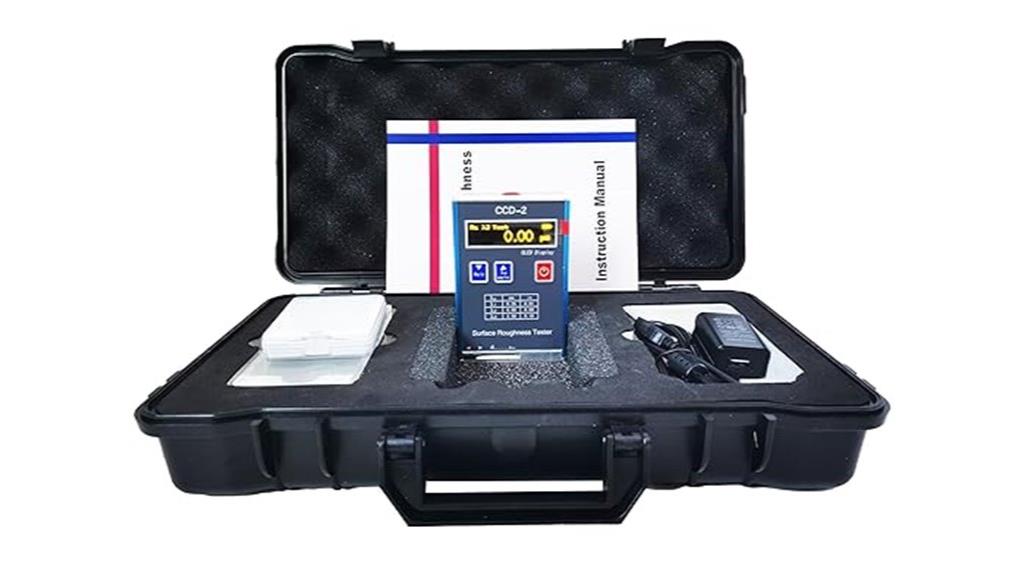
The Digital Surface Roughness Tester Surface Profilometer Gauge is ideal for professionals who need quick, accurate measurements across various material surfaces. Its measuring range covers Ra, Rq from 0.05 to 15.0μm and Rz, Rt from 0.1 to 50.0μm, making it versatile for testing flat, conical, groove, and ex-circle surfaces. Compact and lightweight, it’s perfect for portable use in the field. The device features a durable aluminum shell, an OLED display for clear visibility, and a high-speed DSP processor for rapid data processing. Powered by a rechargeable battery, it supports continuous operation and easy charging, ensuring efficiency during extended measurement sessions.
Best For: professionals in quality control, manufacturing, and research who require quick, accurate surface roughness measurements in various environments.
Pros:
- Versatile measurement range suitable for multiple surface types and materials.
- Compact, lightweight design enhances portability for field and on-site use.
- High-speed DSP processor ensures rapid data processing and results.
Cons:
- Limited to surfaces larger than 80*30mm for groove and conical testing.
- May require calibration and training for optimal use in complex measurement scenarios.
- Battery life, while long-lasting, may need frequent charging during intensive use.
Goyojo GSR750 Surface Roughness Tester
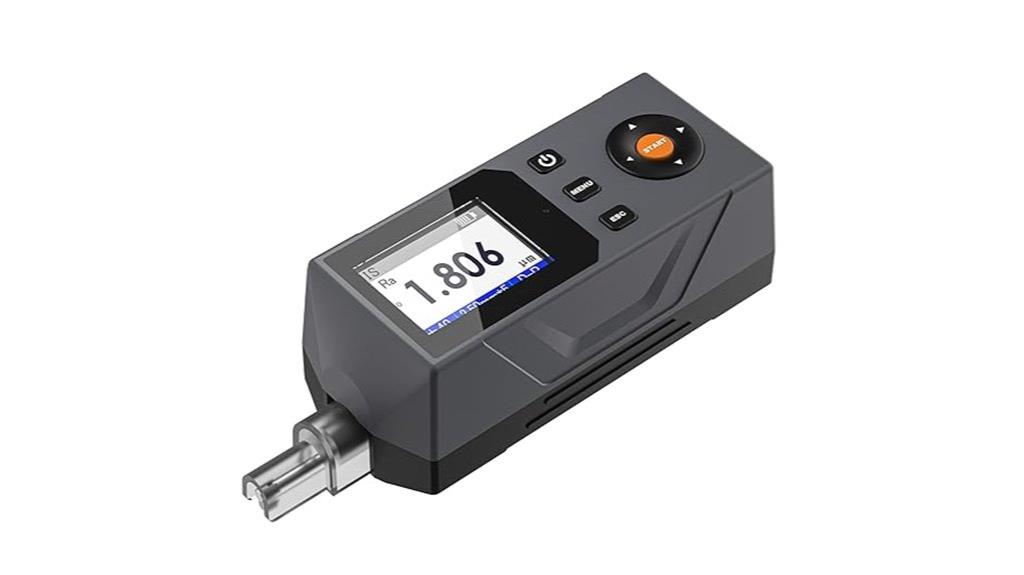
Looking for a surface roughness tester that combines high precision with ease of use? The Goyojo GSR750 offers exceptional multi-parameter profiling, measuring parameters like Ra, Rz, Rq, Rt, and more. Its diamond-tipped sensor guarantees stable, repeatable readings on various surfaces, including metal and coated materials. The large backlit LCD displays live profile curves and data clearly, while features like auto-calibration and Bluetooth connectivity streamline workflow. Compact and lightweight, it’s perfect for field or shop use, delivering high-resolution measurements under 1 micron. Overall, the GSR750 is a reliable, user-friendly tool that enhances quality control across diverse industrial applications.
Best For: professionals in quality control, manufacturing, and maintenance seeking precise, easy-to-use surface roughness measurement tools for diverse industrial surfaces.
Pros:
- High-precision multi-parameter profiling with measurement accuracy under 1 micron.
- User-friendly features like auto-calibration, auto-save, and Bluetooth connectivity for efficient workflow.
- Compact, lightweight, and robust design suitable for field and shop-floor applications.
Cons:
- Auto-zeroing can be challenging and may require careful calibration.
- Advanced filtering options might be complex for new users to optimize.
- Limited details on long-term durability and performance in harsh environments.
Starrett Surface Roughness Tester with Bluetooth and Color Graph Display
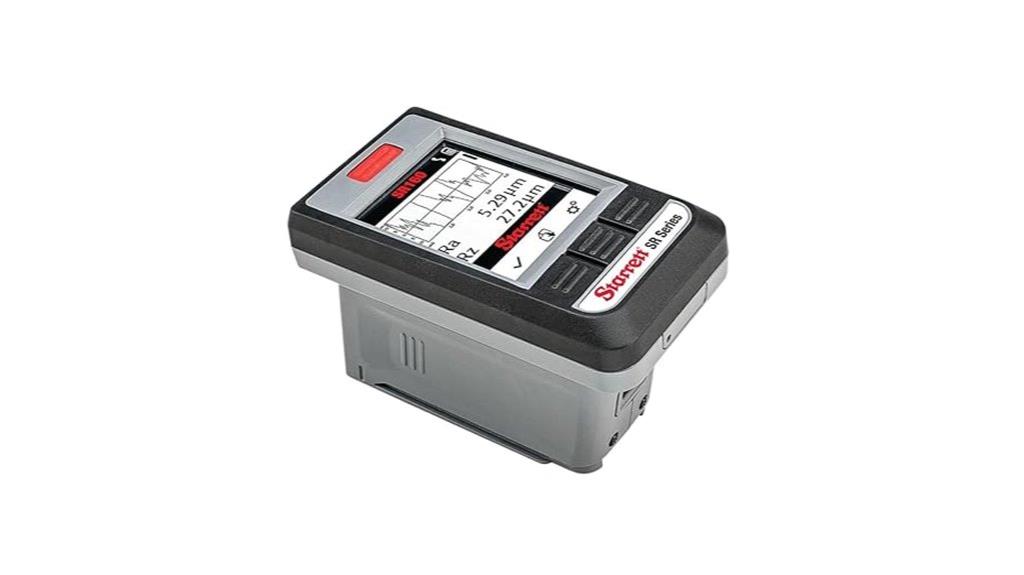
If you’re seeking a reliable surface roughness tester that combines advanced connectivity with clear data visualization, the Starrett SR160 stands out. It features Bluetooth for effortless data transfer and a vibrant color graph display that makes interpreting results straightforward. Equipped with a durable diamond stylus, it ensures precise measurements across parameters like Ra, Rz, Rsk, and more, up to 40 microns. Its high accuracy of ±5% plus 4 micro-inches makes it ideal for detailed surface analysis. With a long-lasting rechargeable battery, it’s built for extended use. However, users should be mindful of potential stylus wear and verify if the device comes with a warranty for added peace of mind.
Best For: professionals and quality control inspectors seeking precise, high-performance surface roughness measurements with advanced connectivity and clear data visualization.
Pros:
- Bluetooth connectivity enables seamless data transfer to devices.
- High-resolution color graph display for easy interpretation of roughness parameters.
- Durable diamond stylus provides precise and reliable measurements over time.
Cons:
- Potential rapid stylus wear may require frequent replacement.
- Durability issues could affect long-term use and reliability.
- Verify if a warranty or service plan is included to address hardware concerns.
GOYOJO Surface Roughness Tester with Calibration Block
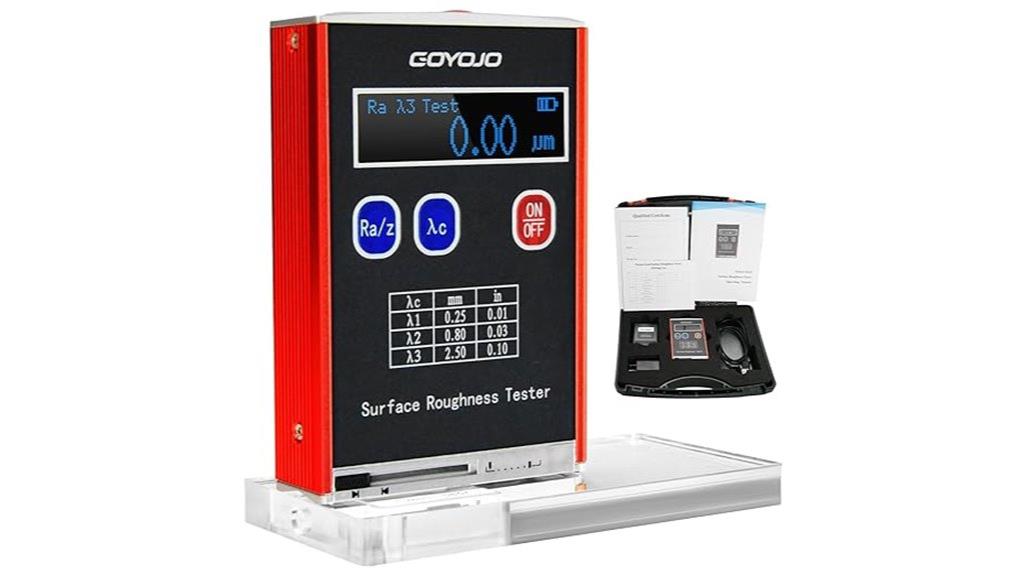
For professionals who need precise surface roughness measurements across diverse materials, the GOYOJO Surface Roughness Tester with Calibration Block stands out as an ideal choice. It delivers high-precision results with an accuracy of 0.01μm, suitable for industries like manufacturing, aerospace, and medical device production. With four tested parameters—Ra, Rq, Rz, and Rt—it handles a wide range of surfaces, including flat, conical, and grooved. Its fast processing, durable design, and user-friendly interface make it perfect for on-site use. The included calibration block guarantees reliability, while its portability and extended battery life support seamless, accurate measurements anytime, anywhere.
Best For: professionals in manufacturing, aerospace, automotive, electronics, materials research, and medical device industries seeking precise, reliable surface roughness measurements on diverse materials and surfaces.
Pros:
- High accuracy of 0.01μm ensures precise surface analysis
- Versatile measurement parameters (Ra, Rq, Rz, Rt) cover a wide range of surface types
- Portable design with long-lasting battery and user-friendly interface for on-site use
Cons:
- May require initial calibration with the included block for optimal accuracy
- The device’s advanced features might be complex for complete beginners without training
- Limited to surface roughness measurements; does not perform other surface characterization tasks
Surface Roughness Tester with 20 Parameters and Portable Profile Gauge
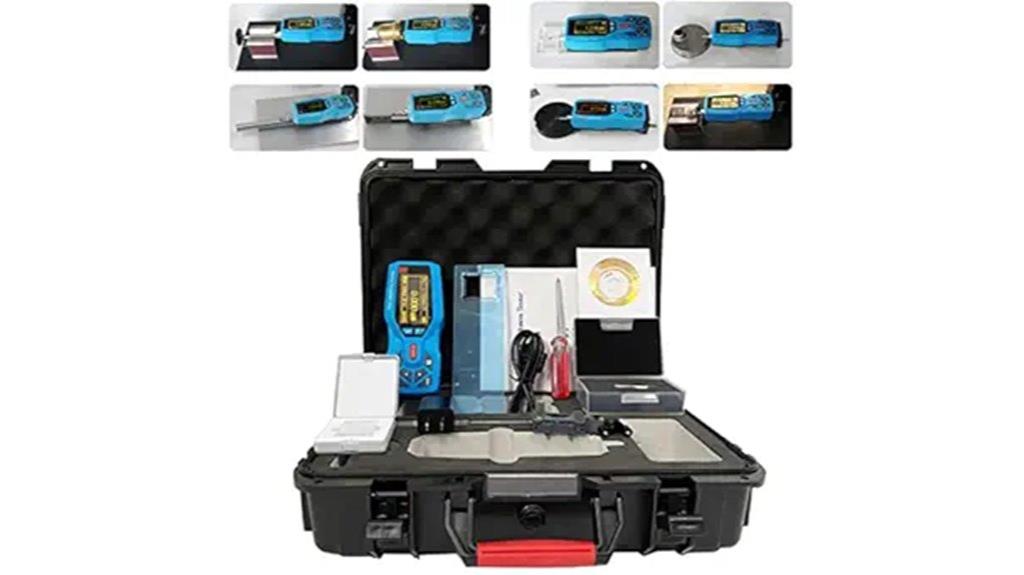
The Surface Roughness Tester with 20 parameters and a portable profile gauge is an excellent choice for professionals who need precise, multi-faceted surface analysis on the go. It tests 20 parameters like Ra, Rz, Rq, and Rsk, with measurement ranges suitable for detailed assessments. The device features real-time clock settings, easy data recording, storage, and seamless connection to computers and printers for data transfer. Its compact design makes it ideal for quality control, research, and manufacturing environments. Offering high cost-effectiveness, it delivers reliable measurements across various parameters, combining surface profilometry capabilities with portability for versatile, on-site surface roughness evaluation.
Best For: professionals in quality control, research, and manufacturing seeking portable, multi-parameter surface roughness analysis with reliable and precise measurements.
Pros:
- Measures 20 surface parameters for comprehensive analysis
- Portable design with real-time clock and easy data management
- Connects seamlessly to computers and printers for efficient data transfer
Cons:
- May have a higher price point due to its advanced features
- Requires proper training to utilize all parameters effectively
- Limited to surface roughness testing, not suitable for other surface characterization needs
Surface Profile Gauge SRT-6223 Handheld Roughness Tester

Designed for rapid and precise surface roughness measurements, the Surface Profile Gauge SRT-6223 Handheld Roughness Tester is ideal for professionals working in both laboratory and field environments. Its compact size and lightweight design make it easy to handle, even in tough conditions. The device measures peak-to-valley height on blast-cleaned surfaces with an accuracy of ±5% or ±5 µm, and a resolution as fine as 0.1 µm. It features USB and RS-232 data outputs for seamless data management and complies with industry standards like ASTM D-4417-B. Overall, it’s a reliable, user-friendly tool for ensuring surface quality across various industrial applications.
Best For: professionals needing rapid, accurate surface roughness measurements in both laboratory and field settings to ensure compliance with industry standards.
Pros:
- Compact, lightweight, and easy to handle in tough environments
- High measurement accuracy with ±5% or ±5 µm and a resolution of 0.1 µm
- Multiple data output options (USB and RS-232) facilitate seamless data management
Cons:
- Some users report calibration difficulties with certain surface types
- Potential delays in customer service responses, such as refunds after returns
- Limited to surface profile measurements; does not provide comprehensive surface analysis
SUNNYSONG Surface Roughness Tester Meter KR110
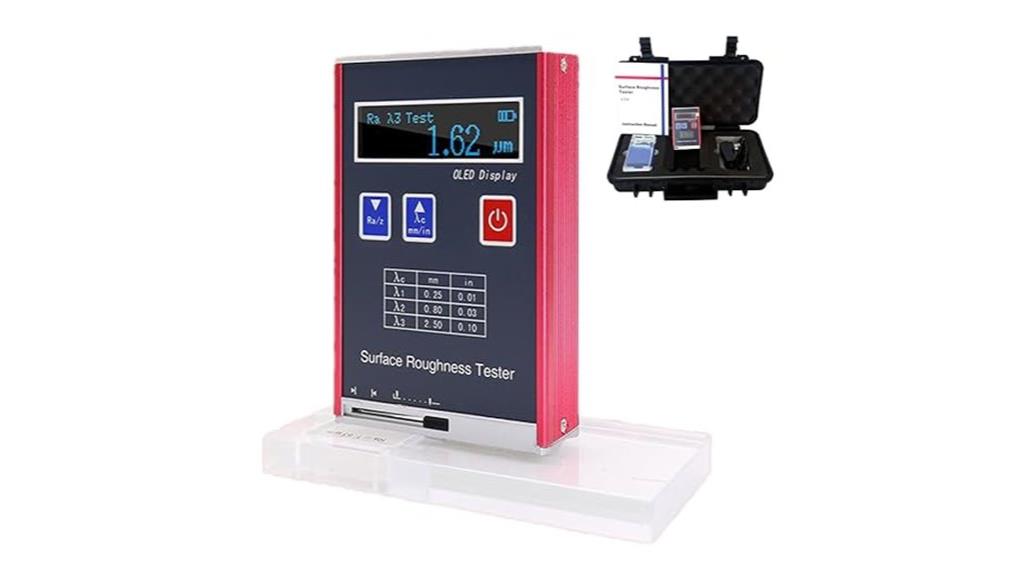
If you need a reliable surface roughness tester that combines high-speed data processing with durable design, the SUNNYSONG KR110 is an excellent choice. It measures Ra, Rz, Rq, and Rt parameters with profilometry, ensuring accurate surface assessments. Built to resist electromagnetic interference, it offers robustness for industrial environments. The device features a bright OLED color display with no visual angle limitations, making readings easy in various lighting conditions. Powered by a rechargeable lithium-ion battery, it supports long operation and quick charging. Despite some user interface quirks, the KR110’s precision, repeatability, and reliable performance make it a standout tool for quality control in 2025.
Best For: industrial quality control professionals seeking a durable, high-precision surface roughness tester with fast data processing and reliable performance.
Pros:
- Accurate measurement of Ra, Rz, Rq, and Rt parameters using profilometry.
- Robust design that resists electromagnetic interference, suitable for industrial environments.
- Bright OLED color display with no visual angle limitations, ensuring easy reading in various settings.
Cons:
- Users may find the manual difficult to decipher, affecting ease of use.
- Charging indicator does not accurately reflect full battery status.
- Slight limitations in user interface prompts that could be improved for better usability.
SUNNYSONG Surface Roughness Tester with Detachable Drive
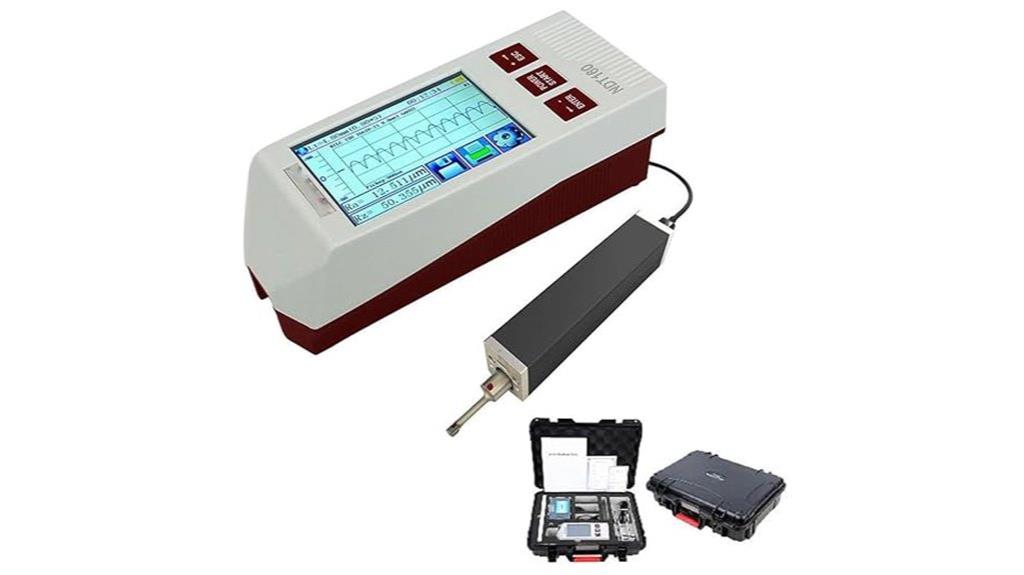
For professionals working in production environments or on mobile measurement tasks, the SUNNYSONG Surface Roughness Tester with Detachable Drive offers exceptional versatility and ease of use. Its split design includes a host, driver, and sensor, enabling measurements of various surface types, including planes, tapered surfaces, and bore interiors. The detachable sensor and flexible delay line (1 to 3 meters) allow inner wall roughness testing of pipes over 40mm diameter. The device provides quick, stable, and accurate readings, displaying all parameters and contour graphics in real time. Compact and lightweight, it’s ideal for on-the-go measurement, supporting international standards and multiple workpiece geometries.
Best For: professionals requiring portable, versatile surface roughness measurement in production and mobile environments across various workpiece geometries.
Pros:
- Split design with detachable sensor and flexible delay line for measuring different surface types and pipe interiors over 40mm diameter.
- Provides quick, stable, and accurate real-time measurement with contour graphics and parameter display.
- Compact, lightweight, and easy to operate in diverse environments, adhering to international standards.
Cons:
- Early failure of probes has been reported, affecting long-term reliability.
- Difficulty sourcing identical replacement parts and consumables such as sensors and cables.
- Limited information on calibration procedures and potential maintenance requirements.
SHAHE Handheld Digital Surface Roughness Tester
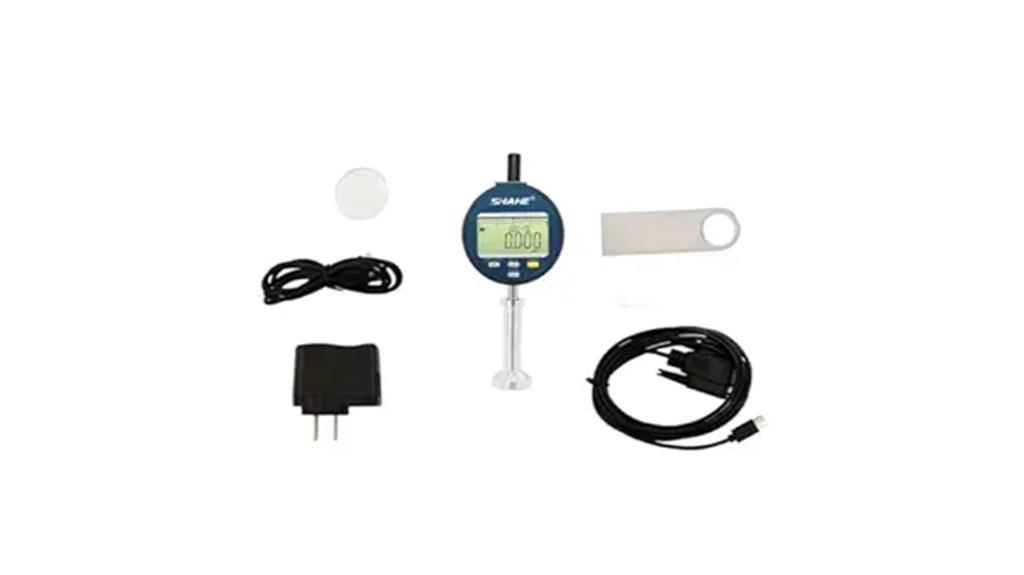
The SHAHE Handheld Digital Surface Roughness Tester GS5337 stands out as an ideal choice for professionals who need precise, on-the-spot measurements across various industrial environments. Its high accuracy (±3μm), wide range (0-6.5mm), and 1μm resolution guarantee reliable results on metal and non-metal surfaces. The device’s compact, waterproof IP54 design makes it easy to operate in tough conditions. With features like data hold, max/min readings, and direct data output via RS232, it streamlines surface analysis. Its rechargeable battery, durable structure, and user-friendly interface make it perfect for measuring flat, inclined, and uneven surfaces in industries like printing, spraying, and mechanical processing.
Best For: professionals in industrial and manufacturing settings needing precise, portable surface roughness measurements on various surfaces.
Pros:
- High measurement accuracy of ±3μm ensures reliable data.
- Wide measurement range (0-6.5mm) suitable for diverse surface types.
- Compact and waterproof design allows use in challenging environments.
Cons:
- Requires proper zeroing and calibration for optimal accuracy.
- Limited to measuring surface roughness up to 6.5mm, may not suit very rough surfaces.
- Dependence on battery life; continuous use demands regular recharging.
SRT-6200 Surface Roughness Gauge with Ra and Rz Measurement
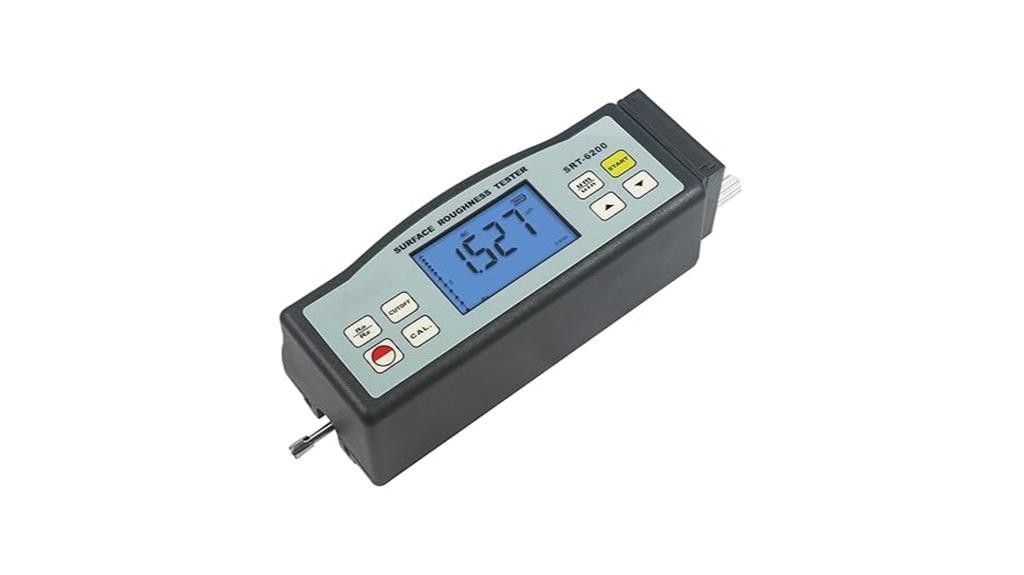
The SRT-6200 Surface Roughness Gauge stands out as an ideal choice for professionals who need quick, accurate measurements of surface texture parameters like Ra and Rz. Its digital design and compliance with ISO, DIN, ANSI, and JIS standards ensure reliable results across industries. Equipped with an advanced inductance sensor, it offers precise readings from 0.05 to 10.00 µm for Ra and 0.020 to 100.0 µm for Rz. The device can store up to seven measurement sets and connect easily to PCs for data analysis. Its lightweight, compact build and rechargeable battery make it highly portable and user-friendly for on-site applications.
Best For: professionals in manufacturing, quality control, and engineering who require quick, accurate surface roughness measurements compliant with international standards.
Pros:
- Provides precise Ra and Rz measurements within wide ranges for versatile applications
- Stores up to 7 measurement sets for efficient data management and easy review
- Compact, lightweight design with rechargeable battery ensures portability and ease of use on-site
Cons:
- Limited to Ra and Rz parameters unless upgraded to the SRT-6210 model with additional measurements
- May require familiarity with standards and measurement procedures for optimal use
- Connection to a PC may need compatible software or interfaces not included in the package
Surface Roughness Tester Meter with 4 Parameters

If you’re looking for a portable and easy-to-use surface roughness measurement tool, the Surface Roughness Tester Meter with 4 parameters is an excellent choice. This compact profilometer measures Ra, Rz, Rq, and Rt, providing precise surface roughness data for metals and non-metals. Its digital backlit display ensures clear readings in various lighting conditions, while its lightweight design makes on-the-go assessments simple. Suitable for quality control and surface analysis, it covers ranges from 0.05 to 50 micrometers. With a 1-year warranty and quick delivery, this device combines accuracy, convenience, and reliability for professional and industrial applications.
Best For: professionals and technicians who need a portable, accurate surface roughness measurement tool for quality control, surface analysis, and on-site assessments across various materials.
Pros:
- Compact, lightweight, and pocket-sized for easy portability and on-the-go use
- Digital backlit display ensures clear readings in different lighting conditions
- Measures four key parameters (Ra, Rz, Rq, Rt) with a wide range for versatile applications
Cons:
- Limited to a measurement range up to 50 μm, which may not suit highly rough surfaces
- Requires calibration and proper handling to ensure consistent accuracy
- Battery life may be limited with frequent use in demanding environments
Factors to Consider When Choosing Surface Profilometers
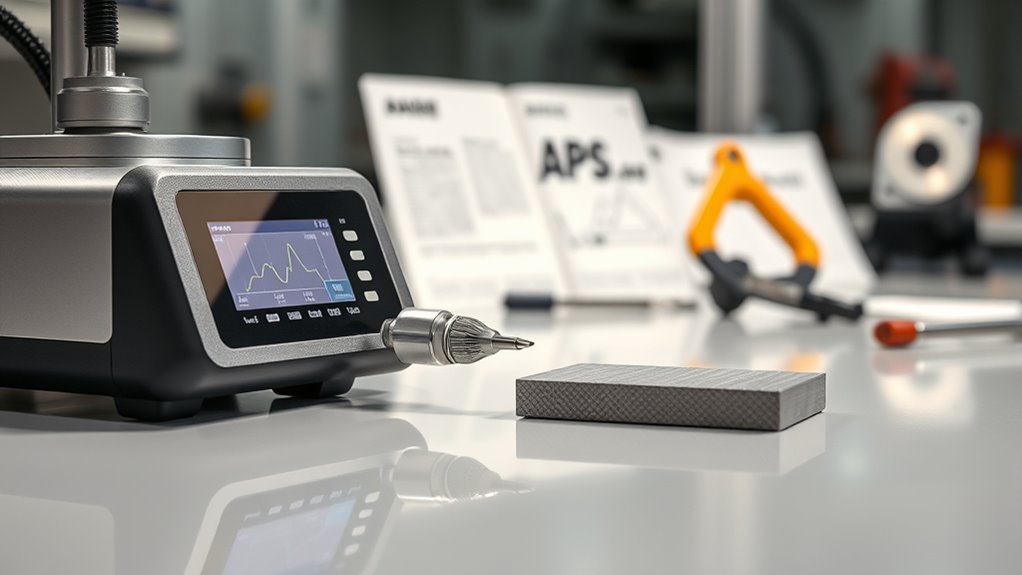
When selecting a surface profilometer, I focus on the measurement range to guarantee it covers my application’s needs. I also consider the variety of parameters it can measure and the accuracy of its sensor technology. Additionally, I evaluate data storage options, transfer capabilities, and whether the device’s size and portability fit my workflow.
Measurement Range Compatibility
Choosing a surface profilometer with the right measurement range is vital to obtaining accurate and meaningful surface data. You need to confirm the device can measure the maximum roughness parameters of your surfaces, like Ra, Rz, Rq, and Rt, so you don’t miss critical details. Verify that its measurement span aligns with your industry standards and application needs, whether in micro-inches or micrometers. It’s also important that the profilometer can handle both fine finishes and rougher textures within its limits. Supporting adjustable cutoff lengths and filter settings helps capture surface features accurately. Additionally, check if the instrument can measure both small-scale variations and larger peak-to-valley heights, ensuring thorough surface characterization without exceeding its measurement capabilities.
Parameter Measurement Variety
A versatile surface profilometer should be capable of measuring a wide range of surface roughness parameters such as Ra, Rz, Rq, Rt, Rv, Rsk, and Rku to deliver a thorough surface profile. This variety guarantees accurate characterization of different surface textures, from fine scratches to deep valleys, meeting specific application needs. Selecting a device that covers multiple parameters reduces the need for multiple instruments, streamlining quality control. It’s also important that the profilometer supports standard measurement protocols, like ISO, JIS, or ASTM, to ensure industry compatibility. By offering a broad parameter measurement range, the profilometer becomes an all-encompassing tool for evaluating both smooth finishes and rough surfaces across diverse materials, making it essential for precise, reliable surface analysis.
Sensor Technology Accuracy
Sensor technology plays a pivotal role in determining the accuracy of surface profilometers, directly impacting the reliability of surface roughness measurements. High-precision sensors like inductance and capacitance types can achieve resolutions as fine as 0.001μm, enabling detailed surface profiling. Regular calibration against certified standards is essential to maintain accuracy, as sensor stability can drift over time. The measurement range and sensitivity also matter, as they determine the device’s ability to capture both minute surface features and larger roughness deviations accurately. High-quality sensors help minimize measurement errors caused by external factors such as electromagnetic interference, ensuring consistent and reliable data collection. When selecting a profilometer, prioritizing sensor technology that offers both precision and stability is key to obtaining trustworthy surface measurements.
Data Storage & Transfer
Have you considered how data storage and transfer capabilities can impact the overall efficiency of a surface profilometer? Adequate internal memory, typically between 100 and 200 datasets, guarantees you won’t run out of space during critical measurements. Support for external interfaces like USB, RS-232, Bluetooth, or Wi-Fi makes it easy to transfer data seamlessly to computers or printers. Export options in formats such as text, CSV, or Excel allow for detailed analysis and reporting. Quick data retrieval is essential, so check if the device offers dedicated software or compatible apps to streamline management. Additionally, features like auto-save or batch processing can save time during large-volume measurements, reducing manual effort and minimizing errors. These factors are vital for maintaining efficiency and accuracy in your measurement workflow.
Device Portability & Size
When selecting a surface profilometer, considering its portability and size can greatly influence how effectively you use the device in various environments. Portable profilometers typically weigh between 0.9 to 1.2 pounds, making them easy to carry and operate on-site. Compact models measure around 5.5 inches long and 2 inches wide, fitting comfortably in one hand or pocket. Many smaller profilometers feature integrated sensors and displays, reducing the need for external equipment and boosting mobility. Their lightweight design allows for quick setup and measurements in tight or challenging spaces without the burden of bulky gear. This portability is especially valuable for fieldwork and on-location inspections, where maneuverability and high accuracy are essential for efficient, precise surface analysis.
Power Supply Options
Choosing the right power supply for a surface profilometer is crucial because it directly affects the device’s portability, ease of use, and suitability for different environments. Battery-powered profilometers, often using lithium-ion batteries, are ideal for on-site measurements, offering mobility and convenience. However, they require regular charging or battery replacements to stay operational. External power options, like AC adapters, are better suited for lab settings where continuous power is available, ensuring uninterrupted measurements. Some models support simultaneous charging and measurement, extending their usability without interruption. The choice between these options impacts the device’s size, weight, and user-friendliness, making it essential to weigh your specific needs—whether you prioritize portability for fieldwork or consistent power for laboratory use.
Calibration & Maintenance
Regular calibration is essential to guarantee that surface profilometers provide accurate measurements within their specified tolerances, often as tight as ±0.01μm. Using certified standards or calibration blocks ensures consistent accuracy over time. Maintenance involves cleaning the stylus or sensor after each use to prevent contamination that can skew readings. It’s also imperative to periodically verify the device’s calibration status, especially after impacts or long periods of inactivity. Proper storage in a controlled environment—avoiding extreme temperatures and humidity—helps preserve the instrument’s precision and lifespan. Routine inspection of mechanical parts and sensor integrity reduces drift and measurement errors. These practices are crucial for reliable, precise surface profiling and should be a key consideration when selecting a profilometer.
Industry Standards Compliance
Ensuring a surface profilometer meets industry standards is essential for obtaining accurate and reliable measurements. Standards like ISO, JIS, DIN, and ANSI set recognized benchmarks that guarantee measurement quality and consistency. Different standards specify parameters, measurement ranges, and filtering methods tailored to specific applications, so choosing a compliant device ensures suitability. Verifying calibration procedures against certified reference surfaces is crucial to maintain adherence and trust in results. Some industries demand additional features like automatic calibration, data logging, or Bluetooth connectivity to meet compliance needs. Regularly updating and validating measurement accuracy against relevant standards is vital for ongoing compliance. Prioritizing these factors helps ensure your profilometer delivers precise, trustworthy surface analysis aligned with industry expectations.
Frequently Asked Questions
How Do Environmental Conditions Affect Surface Profilometer Accuracy?
Environmental conditions can considerably impact the accuracy of surface profilometers. I’ve found that temperature fluctuations cause expansion or contraction of the device components, leading to measurement errors. Humidity can affect sensitive optical parts, while dust or vibrations interfere with precise readings. To guarantee accuracy, I always operate profilometers in controlled environments, keeping conditions stable and free of contaminants, which helps me get reliable, repeatable surface measurements.
What Maintenance Is Required to Ensure Long-Term Measurement Precision?
Maintaining a surface profilometer is like tending a garden—you need consistent care to guarantee it stays precise. I regularly calibrate the device, clean the probes, and check for wear and tear. I also keep the environment stable, avoiding dust or temperature fluctuations. By performing these routine checks and maintenance, I ensure my measurements stay accurate over the long haul, just like a well-tended garden yields healthy blooms.
Are There Specific Calibration Procedures for Different Surface Types?
Yes, there are specific calibration procedures for different surface types. I make sure to adjust the profilometer settings based on whether I’m measuring smooth, rough, or textured surfaces. I also use reference standards that match the surface material to calibrate precisely. Regular calibration checks ensure consistent measurements, and I follow manufacturer guidelines closely to account for surface variability, which helps maintain precision over time.
How Do Measurement Speed and Data Processing Impact Results?
Measurement speed and data processing profoundly impact results, as faster measurements can sometimes sacrifice accuracy, especially on complex surfaces. I’ve found that optimizing processing algorithms ensures quick data analysis without losing precision. When I balance speed with thorough data handling, I get reliable, high-quality measurements. So, choosing a profilometer with efficient processing capabilities helps me achieve both rapid results and detailed, accurate surface profiles.
What Are the Compatibility Requirements for Integrating Profilometers With Other Equipment?
When integrating profilometers with other equipment, I guarantee compatibility by checking their communication interfaces, like USB, Ethernet, or GPIB. I also verify software compatibility and data formats to prevent issues. Power requirements and calibration procedures matter too. By confirming these factors beforehand, I make sure the systems work seamlessly together, enabling accurate, efficient measurements without interruptions or data loss.
Conclusion
Imagine holding a tool that feels like an extension of your hand, effortlessly revealing the hidden textures of surfaces with pinpoint accuracy. These surface profilometers are your gateway to precision, turning complex measurements into a seamless experience. Whether you’re in a lab or on the shop floor, choosing the right device access a world of detailed insights. With the right profilometer, you’ll see your surfaces in a new light—crisp, clear, and perfectly measured.
